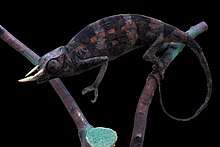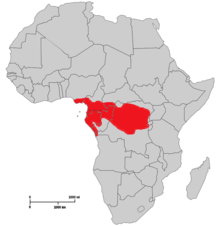Owen's chameleon
| Owen's chameleon | |
|---|---|
 | |
| An Owen's chameleon at the Cantonal Museum of Zoology | |
| Scientific classification | |
| Kingdom: | Animalia |
| Phylum: | Chordata |
| Class: | Reptilia |
| Order: | Squamata |
| Suborder: | Iguania |
| Family: | Chamaeleonidae |
| Genus: | Trioceros |
| Species: | T. oweni |
| Binomial name | |
| Trioceros oweni (Gray, 1831) | |
 | |
| A map illustrating the range of Owen's chameleon | |
| Synonyms | |
Owen's chameleon (Trioceros oweni), also known as Owen's three-horned chameleon, is a species of chameleon native to sub-Saharan Africa. Named after William Fitzwilliam Owen, it was first described in 1831 by the naturalist John Edward Gray, and is the type species of the genus Trioceros.[2]
Distribution and habitat
Owen's chameleon can be found in much of tropical sub-Saharan Africa, from the Niger Delta in Nigeria in the north to Angola in the south and Burundi in the east.[1] It inhabits dense evergreen and semi-deciduous forests at altitudes lower than 800 metres above sea level, usually living in large trees.[3] The type locality for the species is the island of Bioko in Equatorial Guinea.[2]
Description and behavior
Like many other chameleons, Owen's chameleon has a prehensile tail and single claws on its toes. Males tend to have three ringed horns,[4] while females lack crests but have loose skin on their hind legs that gives the impression of wearing baggy trousers. On average, adult Owen's chameleons range from 25 to 28 centimetres,[3] while a typical weight is around 75 grams.[5] The species is generally arboreal and will leap from branch to branch or to the ground in order to avoid predators; it tends to feed on insects.[1]
Conservation and threats
Because of its wide range, abundance, and population stability, Owen's chameleon is ranked Least Concern by the International Union for Conservation of Nature. However, there are concerns that logging and agricultural expansion may contribute to deforestation and potentially threaten the status of the species. In addition, it is occasionally exploited via the pet trade or traded locally to be used in traditional medicine; some tribes in the Democratic Republic of the Congo believe that scorched body of an Owen's chameleon can be used as a protective talisman, while around Yaounde in Cameroon the species is utilized as a treatment for maladies believed to be magical.[1]
References
- 1 2 3 4 "Trioceros oweni (Owen's Chameleon, Owen's Three-horned Chameleon)". www.iucnredlist.org. Retrieved 2017-07-15.
- 1 2 "Trioceros oweni". The Reptile Database. Retrieved 2017-07-15.
- 1 2 Chirio, Laurent; Lebreton, Matthew (2007). Atlas des reptiles du Cameroun. Patrimoines naturels. 67. Paris: Muséum national d'Histoire naturelle. ISBN 9782856536032. OCLC 470695165.
- ↑ Gonwouo, Legrand N.; LeBreton, Matthew; Wild, Chris; Chirio, Laurent; Ngassam, Pierre; Tchamba, Martin N. (20 November 2006). "Geographic and ecological distribution of the endemic montane chameleons along the Cameroon mountain range" (PDF). Salamandra. 42: 213–230. ISSN 0036-3375 – via Mosaic.
- ↑ "Owen's Chameleon - Chamaeleo oweni - Overview - Encyclopedia of Life". Encyclopedia of Life. Retrieved 2017-07-15.
